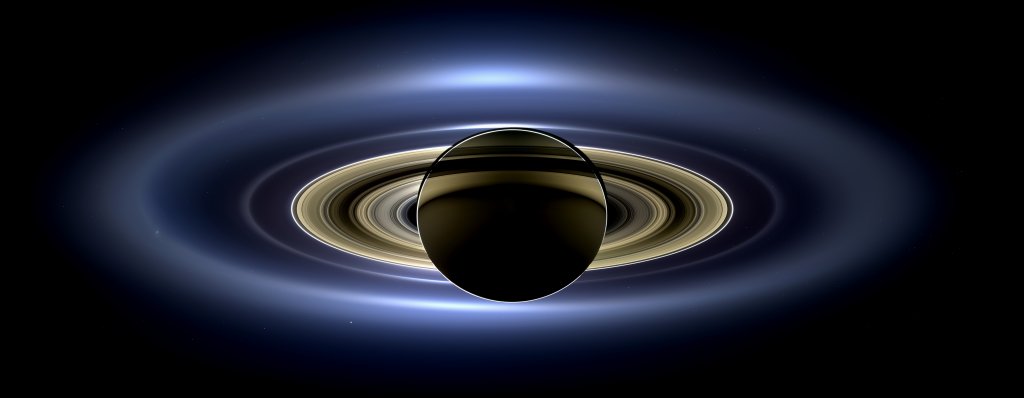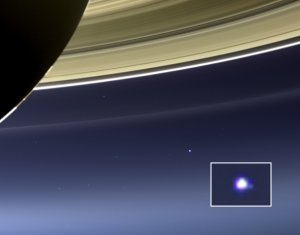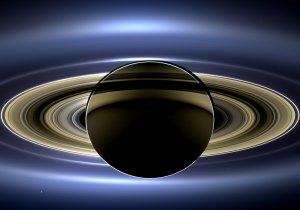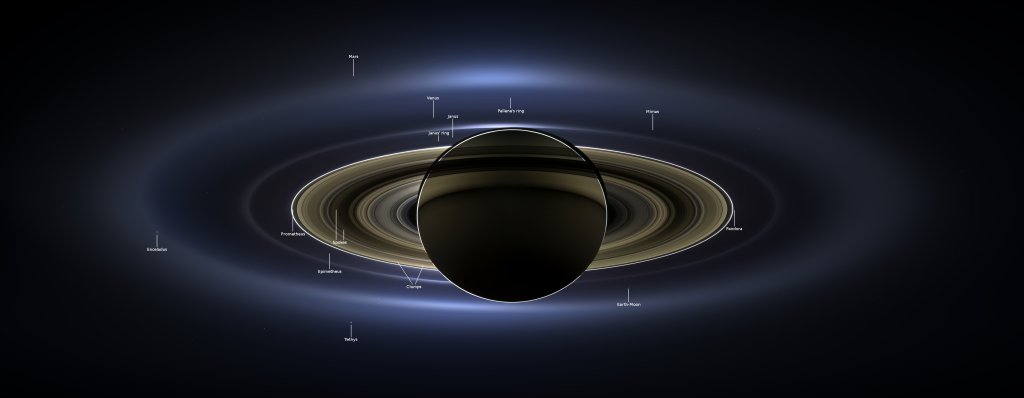

- Image Credit: JLP/NASA (Full image)
Ladies and Gentlemen, after months of waiting, the new Cassini picture is finally here!
Taken on July 19, 2013, it is easily one of the most anticipated astronomy pictures of the year. While 1.2-million kilometers (750,000 miles) from the Ringed planet, Cassini once again snapped a mosaic of Saturn while it eclipsed the Sun.
All in all, the final picture is 9000 by 3500 pixels and glorious. NASA really outdid themselves with this one. All in all, Cassini took 323 pictures over the course of our hours and is colored in natural color. The picture shows an area about 651,591kilometers (404,880 miles) across.
There is a ton of awesome stuff pictured here, so, sit back and enjoy the tour of this beauty.
Our Favorite Mote of Dust

First, the object everyone wants to see is our home in the cosmos. The Earth-Moon system can be seen near Saturn’s lower right side. This is the third picture of Earth taken from the outer solar system and, considering that Earth is only 1.4 billion kilometers (900-million miles) away, it really helps us visualize how tiny our planet really is.
Every human alive today is inside that point of light and, to date, no human has ventured outside of that little haze of light.
In addition to looking back at Earth, you can also see Venus and Mars. With the exception of Mercury, this was a family portrait of the terrestrial planets.
The Magnificent Rings

The centerpiece of beauty for this image is seen in the stunning detail of the Saturnian ring system. Cassini was about 17 degrees below Saturn’s equatorial plane giving us this dynamic view.
In 2006, the previous version of the “Saturn Eclipse” picture revealed the presence of the “bright” E ring (it’s bring in this picture due to the image’s contrast and the position of the Sun, but in reality it’s actually very diffuse and faint).
The ring feature you see on top of this image are the rings as seen from Saturn’s night side. Here, the rings are passing behind Saturn relative to the Sun (between the planet and Cassini’s vantage point) and are still reflecting sunlight.
Saturn’s ring system is very dynamic and contains a host of interesting properties and features; this image is sharp enough that you can see them all (or, at least most of them).
Enceladus and more

In the E Ring, just below the center line of the image, is the moon Enceladus with it’s clearly visible water geysers. This moon is spectacularly interesting as it competes for the title of “most probable place to hold life in our solar system outside of Earth” (competing with Europa, a Galilean moon of Jupiter, and a couple of others). In addition to Enceladus, you can see several of Saturn’s moons if you look hard enough.
Finally (if there is such a thing), you can see back ground stars that pepper the distant sky.
All of the hype surrounding this image was certainly worth it. The final product is as stunning as ever. Panning around the high-resolution image constantly reveals new wonders and fantastic sights. I applaud the JLP team for their incredible efforts.
You can see more information about this picture written by Ciclops and Phil Plait, as always, has an illuminating write up of his own. Below you can see a higher resolution version of this image with markings to point out the most interesting features (but, you’ll probably want to open the image in a new tab so you can zoom into it properly).
